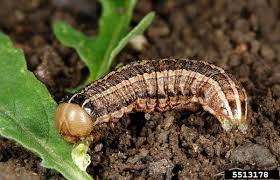 Growing food in your own garden can save you a lot of money, not to mention garden-grown food always tastes so much better than the produce you can buy from the grocery store. Below are some tips for getting rid of common garden pests without spending a lot of money.
Growing food in your own garden can save you a lot of money, not to mention garden-grown food always tastes so much better than the produce you can buy from the grocery store. Below are some tips for getting rid of common garden pests without spending a lot of money.
You can also rely on https://www.pestcontrolexperts.com/local/kansas/wichita/ to help you with your pest control needs.
Cutworms
Cutworms are larvae that hide under leaves or on top of the soil. They are stout looking with a gray or brown coloring. They like to feed on leaves and roots of young plants. Cutworms like to feed on garden plants at night. This pest is known as a cutworm because it feeds below the soil surface on the stem of plants which cuts down young plants. Cutworms can do extensive damage in the garden. How do you get rid of Cutworms? Try one of the following ways in your garden:
-Sprinkle a mix of eggshells and coffee grounds in your garden.
-Use an insecticide. For best results apply the insecticide in the late afternoon.
-Visit your garden after dark. With a flashlight and gloves, pick the cutworms off the plants. Drop the cutworms into water. You should repeat this process a few times a week.
Spider Mites
These are tiny pests that are related to the spider. Spider mites feed on plant juices. The plant’s vitality is lost and turns yellow or brown. A definite sign of a spider mite is finding fine silk webs on the leaves of your plants. Isolate your plant immediately if you feel it has been affected by spider mites. Do the following to rid your garden of spider mites:
-Spray down your plant as thoroughly as possible with pressured water. Try using a garden hose or faucet.
-Use insecticidal oils. Insecticidal oils will cling to the spider mites and effectively kill them. Make sure the plant is completely covered with the oil to be effective.
Squash Bugs
Squash bugs are most often found on squash plants and pumpkins. These pests resemble stink bugs and look as if they are wearing armor. Squash bugs prey on plants by injecting toxins and sucking juices out of them which causes them to wilt and die. A large infestation of these pests will probably require a professional service to eliminate them. Search moxieservices.com for more information on pest control.
Here are some ways you may be able to get rid of them yourself.
-Handpick the culprits and dispose of them in soapy water.
-Scrape off any egg clusters that can usually be found on the back of leaves.
-Set a trap for the bugs. These pests like to come out at night and hide under wood. Place a wooden board in the garden and in the morning check underneath for any bugs. If any bugs are found, they can be scraped off into soapy water.
Whiteflies
Whiteflies are tiny insects. They stunt and weaken plant growth. They will also spray garden plants with a sticky substance that can lead to fungal disease. They are moth-like and often found in groups on the underside of plant leaves. Also, when buying plants from a plant nursery, make sure plants are disease free from culprits like whiteflies. Whiteflies are relatively easy to get rid of. Try the following to remove them.
-Vacuum the flies. Use a small handheld vacuum to suck the pests from leaves.
-Pluck leaves that are infested and dispose of them.
-Remove visibly diseased branches with clippers.
-Cover the garden ground with aluminum foil. This will make it difficult for whiteflies to find a host plant and make them less likely to lay new eggs.
Tomato hornworm
The tomato hornworm is a bright green colored, striped caterpillar. They enjoy eating the foliage from tomatoes, eggplants, and potatoes. The tomato hornworm can be extremely damaging to tomato plants. To rid your garden of this pests, try these tricks:
-Introduce a predator. Introducing a predator can control the problem. Some predators to try include ladybugs, wasps, and birds.
-Apply an insecticide. If you decide to use an insecticide, read the directions carefully before using in your garden.
Japanese Beetles
The Japanese beetle feeds on 300 different plants and can cause significant damage in a garden. The adult beetle is a metallic blue-green color. The larvae are wide and white in color. Here are some ways to beat the infestation:
-If you have a small infestation, try picking the beetle off the plant by hand.
-Also, shake the beetles off the plant into a bucket of soapy water. The soapy water will kill them.
-If you have a large infestation, it is best to call a pest management service because large infestations are difficult to control.




No Comments